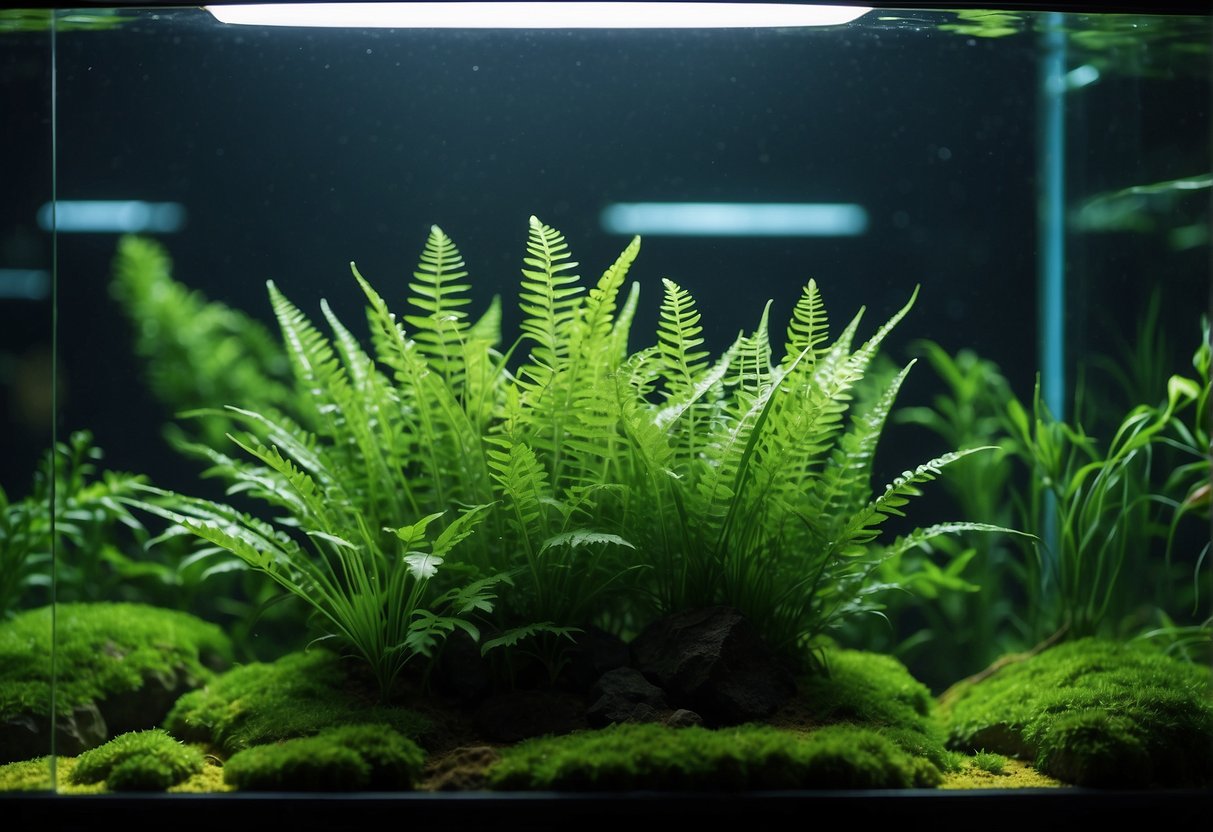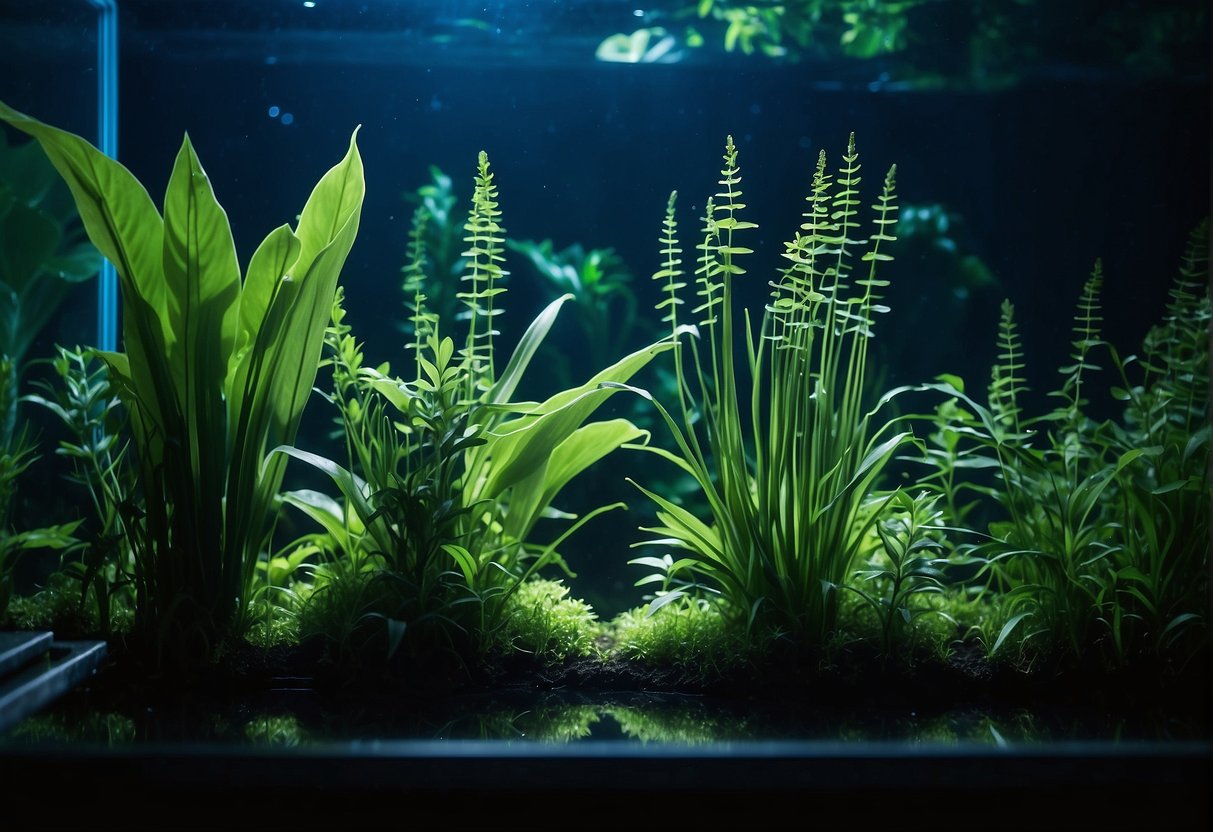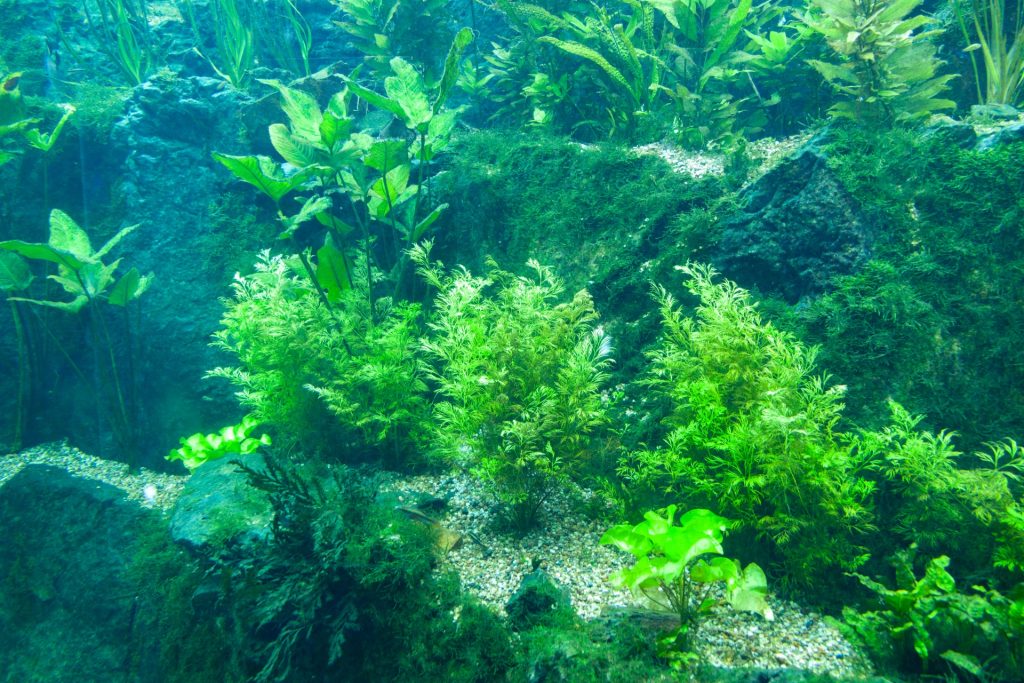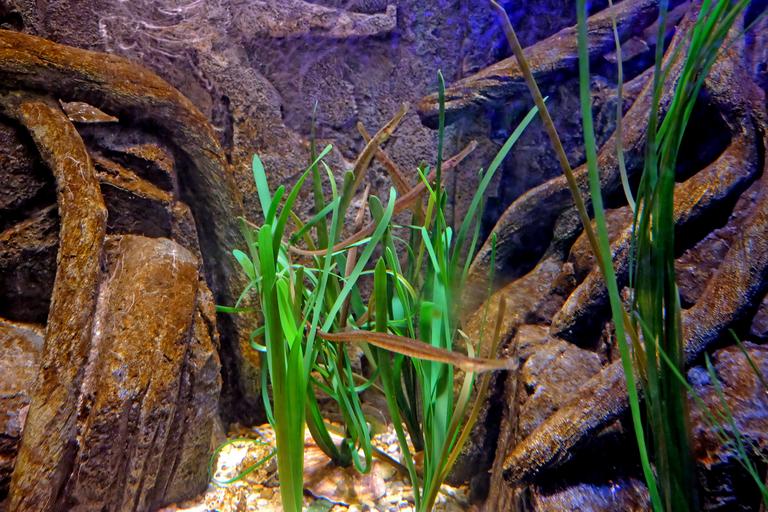Aquarium enthusiasts understand the importance of providing the right environment for their aquatic plants to thrive. One crucial aspect of this environment is proper lighting, which not only contributes to the aesthetic appeal of the aquarium but also ensures that the plants grow healthily. With the advancement in technology, LED lights have become increasingly popular for aquariums, raising questions about their effectiveness in promoting plant growth.

LED lights are energy-efficient, durable, and customizable, making them ideal for many applications, including aquariums. They can be tailored to emit the appropriate spectrum required for optimal plant growth. Many aquarium plants will grow under LED lights if the light emits in the right spectrum. Choosing the right LED lights with the appropriate Kelvin rating, typically between 6,500 and 10,000 Kelvin, is essential to promote healthy plant growth.
The Science of LED Lighting and Plant Growth

Photosynthesis Under LEDs
One of the most important aspects to consider when discussing aquarium plant growth under LED lights is the process of photosynthesis. Photosynthesis is the way plants convert light energy into chemical energy in the form of sugars. Different light sources can provide the specific wavelengths needed for this process, with LED lights being particularly effective.
LED lights can provide the correct type of light for photosynthesis, as they can be designed to emit light within the ideal spectrum for plant growth. This spectrum ranges from 400 to 700 nanometers and is known as the Photosynthetically Active Radiation (PAR) zone.
Specific wavelengths within this range, such as blue (400-500nm) and red (600-700nm) light, are more effective in stimulating the photosynthetic process. These colors effectively stimulate chlorophyll production, a critical component of photosynthesis.
Spectrum and Plant Response
The light spectrum emitted by an LED light source must be carefully considered for optimal aquarium plant growth. Besides the importance of blue and red light, providing other wavelengths to promote balanced and healthy plant growth is also necessary. For instance, green light (500-600nm) plays a role in regulating plant development.
According to Plantophiles, ideal LED lights for aquarium plants burn between 6,500 and 10,000 Kelvins. This range ensures a proper balance of light intensity and spectrum, fostering overall plant health and growth.
Understanding PAR, PUR, and Lumens
- PAR: As mentioned earlier, PAR stands for Photosynthetically Active Radiation and refers to the range of wavelengths (measured in nanometers) most effective for photosynthesis. Understanding the PAR value of an LED light source is crucial for determining its effectiveness in promoting aquarium plant growth.
- PUR: Photosynthetically Usable Radiation (PUR) is more specific than PAR and identifies the wavelengths most efficiently utilized by an individual plant species. While PAR includes the ideal range for overall photosynthesis, PUR focuses on the exact wavelengths best suited to a specific plant’s needs.
- Lumens: Lumens measure the total amount of visible light emitted by a source. According to Tankarium, lumens can provide a general idea of an LED light’s brightness but are not the most accurate way to assess its effectiveness for aquarium plant growth, as they do not measure the light’s spectrum or intensity. Focusing on PAR and PUR values is more helpful in determining the right LED light system for your aquarium plants.
LED Lighting in Aquariums
Advantages of LED Aquarium Lights
LED lights have become increasingly popular for aquariums due to their energy efficiency and longevity. They can produce the appropriate spectrum needed to support the healthy growth of aquarium plants. LED aquarium lights also generate less heat than other lighting options, which helps maintain stable water temperatures in the fish tank.
Another advantage is the adjustable nature of LED lights. LED lights’ intensity and color temperature can be easily tailored to match the specific needs of different plant species. LED lights should burn at between 6,500 and 10,000 Kelvins for optimal plant growth.
Ensuring Adequate Coverage and Intensity
When choosing an LED light fixture for your aquarium, it’s essential to consider both coverage and intensity. The strength of the LED lights should be compatible with the depth of your tank, and the light fixture must spread illumination throughout the entire tank. This ensures that all plants receive the necessary light for growth.
- Coverage – Make sure the LED light fixture is wide enough to cover the entire width of the fish tank.
- Intensity – The strength of the LED light should be matched to the light requirements of the plants in the aquarium. Be aware that the more profound the tank, the stronger the light intensity must be to reach the bottom.
The Importance of Light Timers
Incorporating light timers into your aquarium setup can help regulate the daily light exposure for your plants. This is crucial, as consistent light patterns contribute to the overall health and growth of the plants. Timers automate the process, ensuring the illumination provided by the LED aquarium light is consistent, even when you’re not around to manually adjust the light.
Balancing Light with Aquarium Ecology
Preventing Algae Growth
One of the challenges in maintaining a healthy aquarium is preventing algae growth. Algae can compete with aquatic plants for nutrients and light, reducing plant growth and negatively affecting the overall balance of the ecosystem. An important factor in controlling algae growth is ensuring appropriate light levels for the specific needs of your aquarium plants while avoiding excessive light that can lead to algae proliferation.
Most planted tank lights, including LED technology, have the power to support both low and high-light plant species. However, it’s essential to adjust the brightness according to your plants’ needs and the tank’s height. Overly bright light may cause algae to flourish.
Another aspect to consider is the duration of light exposure. Aquarium plants generally require 8-10 hours of light daily, and excessive exposure can also contribute to algae growth. To maintain a balance, use timers to regulate the light duration in your aquarium automatically.
Aquatic Plants and Fish Requirements
When setting up an aquarium with a mixture of fish and aquatic plants, it is crucial to understand the requirements of both plant species and fish inhabitants. The choice of LED lights should be based on the optimal color temperature (between 6,500 and 10,000 Kelvin) and light intensity compatible with the depths of your tank.
Here are some general guidelines for different groups of aquatic plants:
- Low light plants (e.g., Java Fern, Anubias): 10-30 micromoles of light per square meter per second (μmol/m²/s)
- Medium-light plants (e.g., Amazon Sword, Cryptocoryne): 30-50 μmol/m²/s
- High light plants (e.g., Dwarf Baby Tears, Rotala): 50-80 μmol/m²/s
Note: The exact requirements vary among species, so research your specific plant needs.
CO2 supplementation can also play a role in achieving a balanced and healthy aquarium. Adding CO2 to your aquarium can help plants grow more efficiently, thereby outcompeting algae for nutrients. However, bear in mind that fish also need proper oxygen levels, and excessive CO2 can harm them. Adjust CO2 levels carefully to maintain a harmonious coexistence between plants and fish.
Selecting the Right LED Lights for Your Plants
Understanding Color Temperature and Kelvins
Selecting the right LED lights for your aquarium plants begins with understanding color temperature, measured in Kelvins (K). LED lights for aquarium plants typically range between 6,500 and 10,000 Kelvin, providing a mixture of red, blue, and green light for optimal plant growth.
Red light is essential for photosynthesis, while blue light promotes vegetative growth and overall health. Greenlight, while not directly utilized by plants, enhances the visual appeal of your aquarium.
Light Requirements for Different Plant Species
Different aquatic plant species have varying requirements when it comes to light intensity and duration:
- Low-light plants like Java Fern and Anubias are more forgiving and can grow under low-intensity LED lights (6,500-7,500 Kelvin) or in shaded areas.
- High-light plants such as Baby Tears and Glossostigma require higher light intensity (closer to 10,000 Kelvin) to thrive.
Be sure to research the specific lighting requirements of your plant species to ensure proper growth.
Compatibility with Tank Size
LED lights should be compatible with your tank size, as they must properly penetrate the water column and distribute light across the entire aquarium. Larger tanks require stronger LED lights, while smaller tanks can do with less powerful options. An ideal LED light setup will provide adequate light intensity throughout the tank, catering to the needs of the plant species you are cultivating.
Setting Up Your Aquarium Lighting System
Installation Tips for LED Fixtures
When setting up an aquarium lighting system, it is essential to consider the type of light you will use. LED aquarium lights are an excellent choice due to their energy efficiency, low heat output, and versatility. Start by choosing a high-quality LED light fixture that can supply the appropriate intensity and spectrum for your plants.
Here are a few installation tips to get you started:
- Mounting: Securely attach the LED light fixture to the aquarium, ensuring the entire tank receives adequate lighting. Use brackets or mounting legs for stability.
- Full spectrum: Choose LED lights that emit full spectrum, meaning they contain both cool and warm white LEDs, as well as red and blue ones, to meet the plants’ requirements for photosynthesis.
- Tank depth: Consider the depth of your tank when choosing LED lights; for medium to deep tanks, consider lights such as Fluval Plant Spectrum 3.0 LED or Current USA Satellite Plus PRO.
Configuring Light Intensity and Duration
Once your LED light fixture is installed, you must configure the light intensity and duration to ensure optimal plant growth and health. Keep in mind the following considerations:
- Intensity: The strength of your LED lights should match the needs of your plants. Low-light plants require less intensity, while high-light plants need stronger lighting.
- Timer: Use a timer to automate the lighting schedule. Most plants need around 8-10 hours of light per day. Make gradual adjustments to avoid sudden changes that might stress your plants.
- Moonlight setting: Some LED fixtures come with moonlight settings, which simulate the natural nighttime lighting conditions. This feature can benefit both your plants and the overall aesthetics of your aquarium.
Monitoring and Maintenance
Tracking Plant Growth and Health
Monitoring the growth and health of live plants in an aquarium is crucial for maintaining a thriving aquatic environment. To assess plant growth, keep an eye on the plants’ color, size, and overall appearance. Healthy plants should maintain a vibrant color and steady growth process over time.
Create a simple table like the one below to track the progress of your aquarium plants.
| Plant Name | Date Planted | Initial Size | Current Size |
|---|---|---|---|
| Plant 1 | MM/DD/YYYY | 5 cm | 10 cm |
| Plant 2 | MM/DD/YYYY | 3 cm | 7 cm |
Be cautious of any signs of plant deterioration, such as yellowing or wilting leaves, as these may indicate a problem with lighting or nutrient deficiency. Ensure the LED lights are emitting the right spectrum to facilitate optimal growth.
Regular Care for Long-Lasting LEDs
For long-lasting LEDs, it is essential to perform regular maintenance to ensure their efficiency and lifespan. Keep your LEDs clean by wiping off any dust or debris at least once a month. This will reduce stress on the diodes and ensure optimal light penetration for the plants.
Check the manufacturer’s specifications for your LED lights, as each brand may require different care. By taking these necessary steps, you can prolong the lifespan of your LEDs and contribute positively to the growth and health of your aquarium plants.
Common Questions and Solutions
Troubleshooting LED Lighting Issues
One common question is whether LED lights can support the growth of aquarium plants like Java Moss, Java Fern, and Anubias. The answer is yes, they can; however, it’s important to address some potential problems and find solutions for optimal growth.
Problem 1: Inadequate light intensity
In a planted tank, light intensity is measured in watts per gallon (WPG) or PAR (Photosynthetic Active Radiation). If your tank’s LED lighting isn’t producing sufficient wattage, it could lead to poor plant growth.
- Solution: Ensure LED lights with higher wattage or PAR are used in larger tanks and for plants requiring more light. Check your tank’s specifications and your plants’ requirements to determine the appropriate light intensity.
Problem 2: Incorrect light spectrum
Aquarium plants need light in the right color spectrum to support photosynthesis. Plants will struggle to grow if the LED lights don’t provide an adequate spectrum.
- Solution: Choose LED lights that offer a full spectrum to cater to your plant’s needs. For example, anubias and java ferns may require different light spectrums to grow effectively.
Expert Tips for Optimal Growth
- Light duration: Set the lighting to mimic a natural day-night cycle. Generally, this means keeping LED lights on for 8 to 12 hours daily. For instance, Java moss and Java fern thrive in moderate lighting conditions.
- Water parameters: Ensure that your tank has stable water parameters. Monitor temperature, pH, and nutrient levels, affecting plant growth.
- Fertilization: Fertilizing aquarium plants can promote better growth. Research the specific requirements of your plants and consider using liquid fertilizers or root tabs.
- CO2 supplementation: If you have a densely planted tank or are growing plants with high light requirements, CO2 supplementation can help improve plant growth and overall health.
- Avoiding algae: To prevent algae growth, balance your tank’s light, CO2, and nutrient levels. If algae becomes an issue, consider adding algae-eating creatures like snails or shrimp to help maintain the ecosystem.



